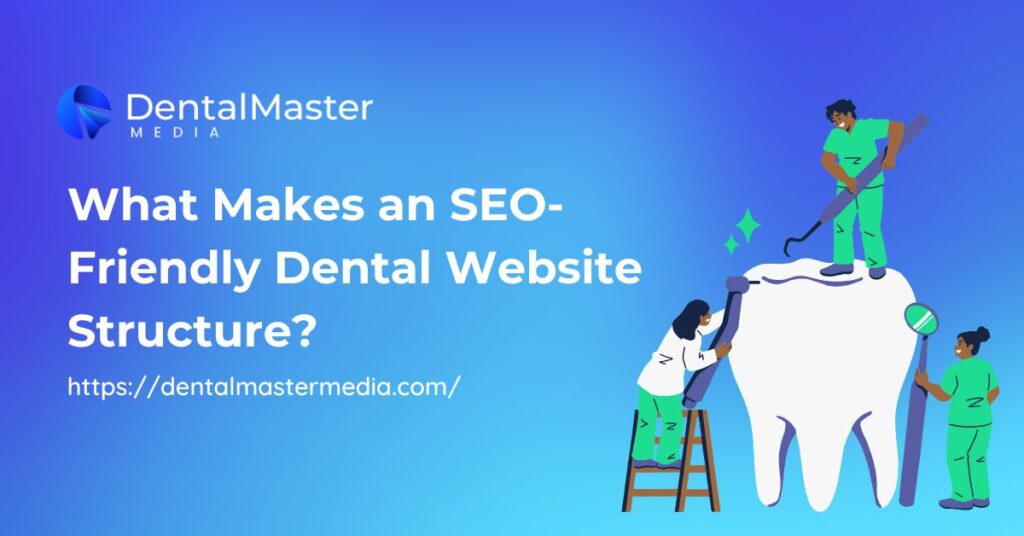Ever wonder why some dental websites appear at the top of Google while others don’t show up at all? It’s not just about having good-looking images or flashy animations. One major reason is the website’s structure.
A clear, easy-to-navigate structure helps both patients and search engines. If your site feels organised and makes sense, visitors will stay longer, find what they need, and trust your clinic.
At the same time, search engines like Google will have an easier time reading your site and showing it to people searching for dental services nearby.
Let’s break it all down in simple terms and look at what makes a website structure truly SEO-friendly for dentists.
What Is Website Structure?
Think of Your Website Like a Dental Clinic
Imagine walking into a dental clinic for the first time. The reception desk is easy to find, treatment rooms are clearly marked, and you know exactly where to go for X-rays or fillings. Now imagine a clinic with no signs, random hallways, and no idea where anything is. You’d probably leave, right?
A website works the same way. If visitors can’t figure out how to find a service or contact you, they’ll click away.
But when a website is set up logically—just like a well-run clinic—people stay longer and feel more comfortable. That’s good for business, and it’s also great for SEO.
This is exactly what Professional SEO Services for Dentists focus on—creating a structure that works for both search engines and real people.
The Basics of Website Structure
A dental website typically includes these main pages:
- Homepage
- Services (with individual pages for each service)
- Contact Us
- About the Dentist/Clinic
- Blog
Each of these pages should be linked in a clear way. The homepage is your entry point. From there, users should easily find what they’re looking for—whether it’s teeth whitening, dental implants, or your clinic’s phone number.
Why a Good Structure Helps Your Dental SEO
Google Loves Clear Organisation
Search engines crawl your site like they’re reading a book. If your pages are structured logically, with clear links between them, Google can easily understand what your site is about. This makes it more likely to rank your pages higher in search results.
If your services are hidden under confusing menus or buried five clicks deep, search engines may overlook them. That means fewer people will find you online.
Patients Find What They Need Faster
Let’s face it—no one likes hunting through a messy website. If your structure is clear, visitors will quickly find answers to their questions.
This reduces bounce rates (when people leave your site quickly) and increases the time they spend reading your content. Google notices this kind of behaviour and rewards it with better rankings.
Key Features of an SEO-Friendly Dental Website Structure
Logical Page Hierarchy
Think of your website like a tree:
- The homepage is the trunk.
- Main pages like “Services” or “About Us” are the big branches.
- Subpages like “Teeth Whitening” or “Braces” are the leaves.
This structure helps visitors understand where they are and what’s connected. It’s simple, clean, and makes sense.
Clean URLs That Make Sense
Avoid web addresses filled with random letters or numbers .This will look better, read better, and help Google understand the content of the page.
Internal Linking That Guides Visitors
Good websites gently guide visitors to other helpful pages. For example, a blog post about “Foods That Stain Your Teeth” could link to your teeth whitening service.
This keeps users engaged and improves SEO service by helping search engines crawl your entire site.
Internal links also tell Google which pages are important. If many pages link to your “Emergency Dentist” page, Google may consider that page more valuable.
Mobile-Friendly Design
Most people now browse on their phones. Your website must look and work well on smaller screens.
Menus should be simple, buttons should be easy to tap, and pages should load fast. Google gives extra ranking points to mobile-friendly websites.

Fast Loading Pages
Speed matters. If your pages take too long to load, visitors may leave before they even see your content.
That sends a bad signal to Google. Compress images, remove unnecessary animations, and make sure your site is hosted on a reliable server.
Clear Navigation Menus
Your top navigation menu should list the most important pages: Home, Services, About, Blog, Contact.
Avoid long dropdown lists or confusing categories. The goal is to help people find what they need in one or two clicks.
How Dentists Can Create an SEO-Friendly Structure
Start with the Right Sitemap
A sitemap is a simple file that shows how your website is organised. Think of it as a floor plan for search engines.
Tools like Google Search Console use your sitemap to crawl and index your pages more effectively.
If you have a clear structure and submit your sitemap properly, Google is more likely to rank your pages well.
Keep Each Page Focused
Don’t try to cover everything about dentistry on one page. Each service—like root canal, Invisalign, or wisdom tooth removal—deserves its own page.
This makes it easier for patients to find exactly what they’re looking for and helps search engines show your page to the right audience.
For example, if someone types “root canal treatment near me,” they should land directly on your root canal page—not a general services page.
Add Breadcrumbs for Easy Navigation
Breadcrumbs are small links at the top of a page that show users where they are. For example:
Home > Services > Dental Implants
They make it easier to move between sections and help Google understand your site’s structure even better.
Use Clear Headers and Titles
Every page should have one main heading (called an H1), followed by subheadings (H2s and H3s).
This helps break up the content and makes it easier to read. Search engines also look at these headers to understand what the page is about. Use your keywords naturally in these headings.
Real-World Example: Building a Website That Patients (and Google) Love
Dr. Patel’s Clinic: A Simple, Effective Layout
Let’s say Dr. Patel runs a dental clinic with various services. His homepage briefly describes what the clinic offers and features easy links to his most popular services.
Each treatment has its own page—clearly titled and easy to find. A patient interested in Invisalign lands on the Invisalign page and sees useful content, pricing details, and a call to book a consultation.
The clinic’s blog includes helpful posts like “How to Care for Clear Aligners” or “Top Signs You Might Need a Root Canal.” These posts link back to relevant service pages, keeping visitors engaged.
Why This Works
This layout works because it’s simple. It helps patients find answers fast, and it helps Google understand what the clinic offers. As a result, the site ranks better, gets more traffic, and sees more appointment bookings.
Common Mistakes That Hurt Website Structure
Too Many Pages That Do the Same Thing
If you have multiple pages that cover the same topic—like five pages about teeth whitening—it confuses both users and search engines. Stick to one strong page for each topic. Focus on making that one page detailed and useful.
Hard-to-Find Contact Info
Your phone number, address, and booking button should be easy to find on every page. If visitors have to dig around just to contact you, they’ll likely give up and move on to another clinic.
No Internal Links
Don’t let your pages stand alone. Each blog post or service page should link to others. For example, a blog post about “Tooth Sensitivity” could link to the “Fluoride Treatments” service page. Internal links help guide your visitors and make your site easier for search engines to crawl.
How Dental Master Media Helps Dentists Structure for SEO
At Dental Master Media, we understand that dental seo websites aren’t just about looks—they’re about structure.
We help dentists organise their websites in a way that feels natural to visitors and friendly to Google’s search algorithms.
We build clean, logical sitemaps, create pages with a purpose, and use smart internal links that boost traffic.
Our goal is to make sure your website doesn’t just exist—it performs. Whether you’re just starting out or need a revamp, we can help build the strong foundation your site needs to rank.
Conclusion:
A good website structure does more than look nice. It helps people find what they’re looking for, makes your content easier to read, and boosts your visibility in search engines.
Clear headings, well-organised menus, fast loading speeds, and mobile-friendly design are all key ingredients.
And remember—getting great results online starts with the basics. A strong website structure builds trust with patients and gives search engines what they need to rank your site.
So if you’re ready to attract more visitors and turn clicks into appointments, don’t overlook structure.
That’s where Dental Master Media can help you build a smarter, stronger foundation for your dental website.

Suraj Rana is the owner of Dental Master Media and a leading expert in SEO for dental practices. With a passion for dental marketing, he has successfully helped numerous dental clinics climb the search engine ranks. Suraj’s expertise makes him a go-to resource for effective, results-driven dental marketing.

